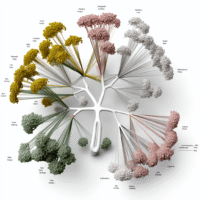Vladimir Dyachkov PhD
-
Build an Advanced AI Agent with Semantic Kernel and Gemini: A Step-by-Step Guide for Developers
Understanding the Target Audience The primary audience for this tutorial includes software developers, data scientists, and business managers eager to leverage AI to enhance operational efficiency. These professionals are typically familiar with programming concepts and possess experience in AI and machine learning frameworks. Their main challenges often involve: Integration Challenges: They face difficulties in seamlessly […] ➡️➡️➡️
-
NVIDIA’s Jet-Nemotron: 53x Faster Language Models with 98% Cost Reduction for AI Solutions
Understanding the Target Audience The Jet-Nemotron series primarily targets three groups: business leaders, AI practitioners, and researchers. Each group faces unique challenges and seeks specific outcomes. Business Leaders: They are looking for cost-effective AI solutions that can enhance operational efficiency and improve return on investment (ROI). AI Practitioners: These individuals focus on deploying advanced models […] ➡️➡️➡️
-
Google AI’s Gemini 2.5 Flash Image: Revolutionizing Image Generation and Editing with Natural Language
What Makes Gemini 2.5 Flash Image Impressive? Gemini 2.5 Flash Image is a groundbreaking tool that leverages advanced AI technology to transform the way we generate and edit images. Built on the robust foundation of Gemini 2.5, this model allows users to create and modify images simply by describing them. This capability includes: Combining multiple […] ➡️➡️➡️
-
Understanding MLSecOps: Essential Tools for Secure Machine Learning CI/CD in 2025
Understanding the Target Audience for MLSecOps The audience for this article primarily consists of professionals involved in machine learning initiatives. This includes: Data Scientists Machine Learning Engineers DevOps and SecOps Teams Compliance and Regulatory Officers CIOs and CTOs These individuals face several challenges, such as managing risks related to data security and compliance, navigating the […] ➡️➡️➡️
-
Boost Your LLM Performance: How Stanford’s Optimistic Algorithm Cuts Latency by 5x
The Hidden Bottleneck in LLM Inference In the rapidly evolving landscape of artificial intelligence, large language models (LLMs) like GPT-4 and Llama are at the forefront, powering everything from chatbots to coding assistants. However, a significant challenge persists: LLM inference—the process of generating responses—can be up to five times slower than it should be. This […] ➡️➡️➡️
-
Building an Efficient Local Machine Learning Pipeline with MLE-Agent and Ollama
Building a Reliable End-to-End Machine Learning Pipeline Using MLE-Agent and Ollama Locally Creating a reliable machine learning pipeline can be a challenging task, especially when it comes to managing dependencies, ensuring reproducibility, and maintaining data privacy. This article will guide you through the process of setting up a local machine learning workflow using MLE-Agent and […] ➡️➡️➡️
-
Microsoft’s VibeVoice-1.5B: Open-Source Text-to-Speech Model for Engaging Multi-Speaker Audio
Microsoft has recently unveiled VibeVoice-1.5B, an open-source text-to-speech model that pushes the boundaries of voice synthesis technology. This innovative tool can generate up to 90 minutes of speech featuring four distinct speakers, making it a game-changer for various applications, from content creation to customer service. Understanding the Target Audience The primary users of VibeVoice-1.5B include: […] ➡️➡️➡️
-
SEA-LION v4: Unlocking Multimodal Language AI for Southeast Asia Researchers and Businesses
SEA-LION v4 is an innovative multimodal language model tailored specifically for Southeast Asia, developed by AI Singapore (AISG) in collaboration with Google. This open-source model is built on the Gemma 3 architecture and is designed to support the region’s diverse languages, many of which have limited digital resources. With capabilities in both text and image […] ➡️➡️➡️
-
GPUs vs TPUs: A Comprehensive Guide for Data Scientists Training Large Transformer Models
Understanding the Differences Between GPUs and TPUs in Training Large Transformer Models When it comes to training large transformer models, the choice between Graphics Processing Units (GPUs) and Tensor Processing Units (TPUs) can significantly impact performance, cost, and efficiency. This article breaks down the key differences, helping data scientists, machine learning engineers, and business decision-makers […] ➡️➡️➡️
-
Revolutionizing Medical AI: Google’s g-AMIE Enhances Accountability for Clinicians
Understanding the Target Audience The g-AMIE system is designed primarily for healthcare professionals, including licensed clinicians, nurse practitioners (NPs), physician assistants (PAs), and healthcare administrators. Their primary concerns revolve around the need for efficient and accurate diagnostic processes while ensuring patient safety and adhering to regulatory standards. Goals for these professionals include improving patient outcomes, […] ➡️➡️➡️
-
Implementing LLM Arena-as-a-Judge for Evaluating Language Model Outputs
Implementing the LLM Arena-as-a-Judge Approach In the evolving field of artificial intelligence, particularly in customer service automation, evaluating large language model outputs effectively is crucial. The LLM Arena-as-a-Judge approach provides an innovative way to do this by comparing model outputs head-to-head rather than relying on isolated numerical scores. This method assesses responses based on defined […] ➡️➡️➡️
-
Build Flexible Multi-Model Workflows in GluonTS: A Coding Guide for Data Scientists and Analysts
Understanding the Target Audience The target audience for this coding guide primarily includes data scientists, machine learning engineers, and business analysts. These professionals are keen on enhancing their forecasting capabilities using GluonTS, often possessing familiarity with Python programming and a foundational understanding of time series analysis. They face several challenges, such as managing multiple forecasting […] ➡️➡️➡️
-
Understanding Modern Databases: Types, Examples, and Applications for Developers in 2025
Understanding Databases in the Modern Tech Era In our increasingly digital landscape, databases serve as the crucial backbone for various applications, from mobile platforms to complex enterprise systems. Grasping the different types of databases and their unique applications is vital for anyone involved in developing software solutions—whether you’re an entrepreneur working on a startup idea […] ➡️➡️➡️
-
Build vs Buy for Enterprise AI in 2025: A Decision Framework for U.S. VPs of AI
As organizations increasingly turn to artificial intelligence (AI) to enhance their operations, VPs of AI Product in U.S. enterprises face a crucial decision: whether to build AI solutions in-house, buy them from vendors, or blend both approaches. This decision is not just a matter of preference; it carries significant implications for compliance, cost, and strategic […] ➡️➡️➡️
-
Designing a Graph-Structured AI Agent with Gemini: A Step-by-Step Implementation for AI Developers
Understanding the Target Audience The target audience for this article includes AI developers, data scientists, and business managers who are keen on integrating advanced AI capabilities into their operations. These professionals are typically familiar with programming and AI concepts, but they seek practical applications that can enhance productivity and improve decision-making processes. Pain Points Many […] ➡️➡️➡️
-
GPZ: Revolutionizing Particle Data Compression with GPU Acceleration for Researchers
Understanding the Target Audience The primary audience for GPZ consists of researchers and practitioners in fields such as cosmology, geology, molecular dynamics, and 3D imaging. These professionals confront significant challenges related to managing large-scale scientific datasets, often comprising billions or even trillions of discrete points. Their main pain points include: Difficulty in efficiently compressing and […] ➡️➡️➡️
-
Prefix-RFT: A Unified Framework for Enhanced Machine Learning with SFT and RFT
Understanding the Target Audience The target audience for Prefix-RFT includes machine learning researchers, data scientists, and business leaders interested in advanced machine learning techniques. They often face challenges with existing fine-tuning methods, such as the rigidity of supervised fine-tuning (SFT) and the instability of reinforcement fine-tuning (RFT). Their primary goals are to enhance model performance, […] ➡️➡️➡️
-
Master JSON Prompting for LLMs: A Python Guide for AI Developers
Understanding JSON Prompting for LLMs JSON Prompting is a game-changing technique for structuring instructions to AI models. By using JavaScript Object Notation (JSON), this method enhances clarity and precision in prompts. Traditional text-based prompts can often lead to misunderstandings, but JSON organizes information into key-value pairs, arrays, and nested objects. This structured approach ensures that […] ➡️➡️➡️
-
Top 9 AI Voice Agent Platforms for Businesses in 2025
In today’s fast-paced business environment, understanding the role of voice agents in artificial intelligence is crucial for organizations looking to enhance customer engagement and streamline operations. Voice agents are not just a trend; they are transforming the way companies interact with their customers and manage internal processes. What is a Voice Agent? A voice agent […] ➡️➡️➡️
-
Large vs. Small Language Models: A 2025 Guide for Financial Institutions
In the rapidly evolving landscape of finance, the choice between Large Language Models (LLMs) and Small Language Models (SLMs) has become critical for institutions looking to leverage artificial intelligence effectively. Understanding the nuances of these technologies can enhance operational efficiency, compliance, and customer service. This article delves into the practical considerations for financial professionals as […] ➡️➡️➡️

















